You are reading the older HTML site
Positive Feedback ISSUE
13may/june 2004
Art goes to Home Entertainment 2004, Part 2
by Art Shapiro
In figuring out a coherent way to present my impressions of the show, I’ve decided to make this report the colored page. No, we’re not talking race relations here—everyone got along just fine at HE2004. I’m talking about visual flamboyance, as exemplified by the orange Soundations rack shown in my last report.
One firm that broke the color barrier a few years ago is Odyssey, the budget offshoot of Symphonic Line. While not trivially inexpensive, this company’s wares have always offered extraordinary value for the money, and the fine sonics are housed in surprisingly massive chasses with thick faceplates heavily anodized in a variety of attractive colors. Here’s a shot of Odyssey’s Klaus Bunge, or at least his legs, as he passed in front of his purple and red electronics; these are just two of a number of eye-catching colors in his product line.
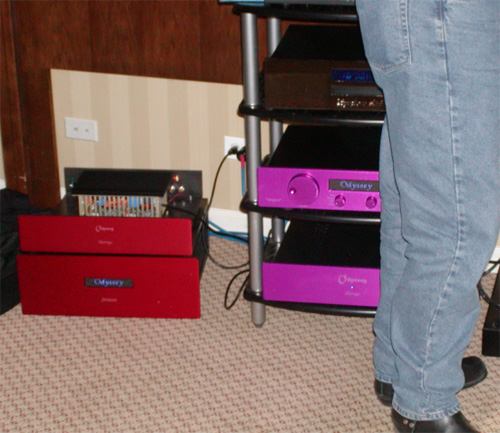
Here we can see a similarly splendid red amplifier from Perreaux. Coupled with the unfamiliar (to me) Swiss Piega speakers, the room was producing attractive sound that caused me to sit a spell and enjoy. These speakers did not fit the stereotype of Swiss systems being sterile and cold.
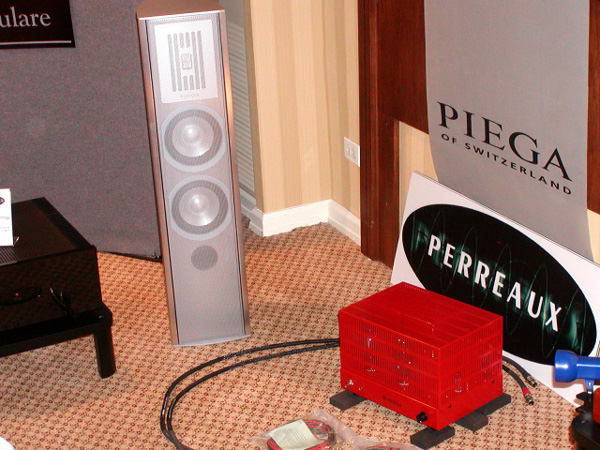
If we can broaden our scope to include colorful names, we can certainly mention Red Planet Labs, a brand of solid state amplifiers attracting some attention in the Southern California area this reviewer calls home. Here’s a picture of the Red Planet room.
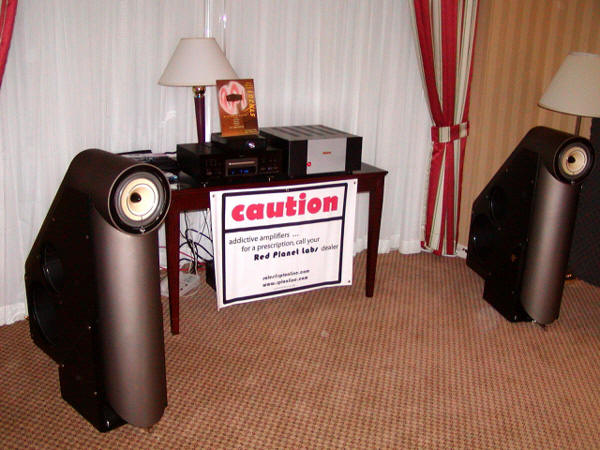
And here’s a closer view with Red Planet guru Daniel Marz (hmmm… is that a coincidence?).
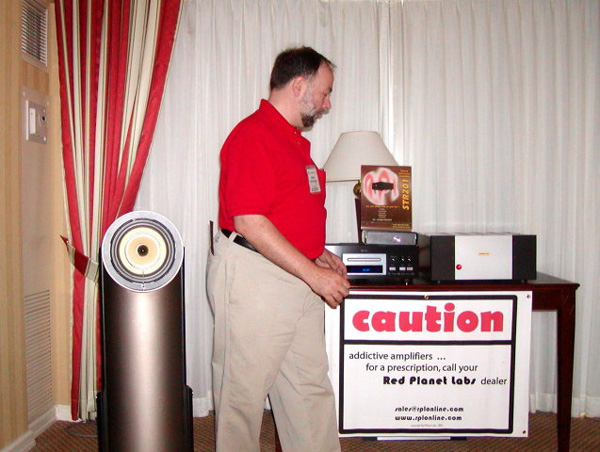
The speakers are Second Rethms. They are based on the Lowther DX4, a full range driver.
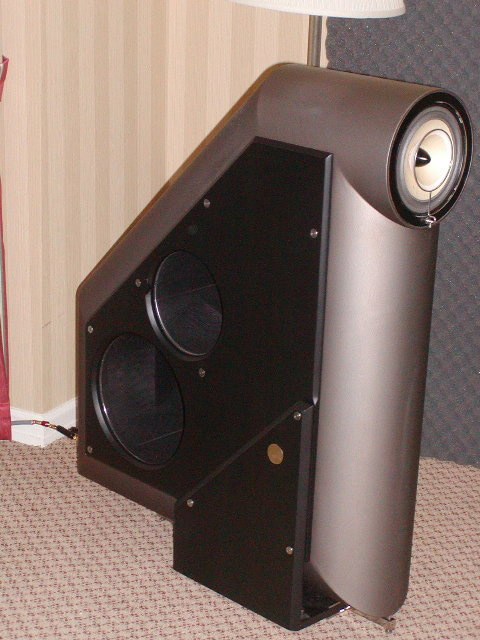
Another undeniably colorful product is the Testa Rosa turntable from Redpoint Audio Design.
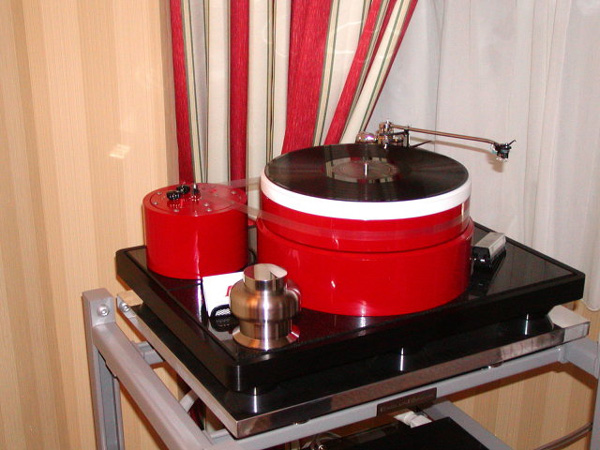
That large metal contraption on the corner closest to us is the massive record weight, as shown in action here.
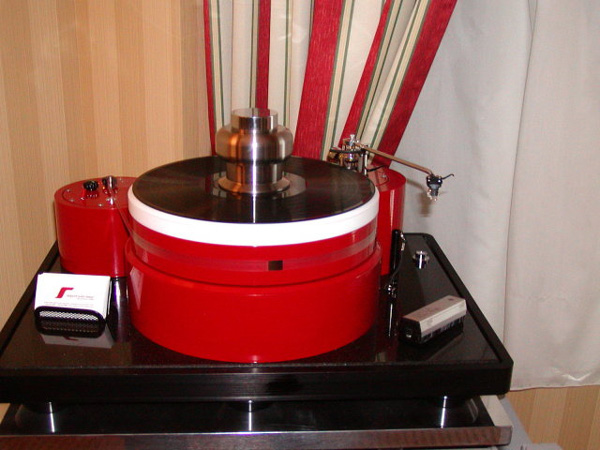
The belt in this unit is actually clear tape leader from old half-inch professional audio reel-to-reel tape, joined by the silver gummy doodads that were used to attach leader to the actual magnetic tape. The Redpoint representative, whose name I seem to have misplaced, told me that ordinary video tape from a VHS cassette (guess one cassette will give him a lifetime supply) actually sounds better than the clear leader, but doesn’t photograph as well. So for show purposes he went with the clear. He also expressed the opinion that only about one out of every three "belts" that he makes sounds good, and that he discards about 2/3 of them. I don’t think he elaborated on this, but he pointed out that other than a little bit of time to fabricate each one, the cost is inconsequential.
This turntable was being used in a room with Innersound ribbon speakers, which sounded quite nice on many pieces of music, but had some dynamic constriction issues handling the piano music that this reviewer uses for most of his listening. Still, an attractive room. On one visit, the turntable was spinning a nice piece of music, and suddenly there was a grotesque burst of noise from the speakers, causing everyone in the room to jump. It turned out that the turntable was supported on its rack by three assemblies of metal disks and truncated cones with Rollerball-type bearings. And a disk in one of the three stacks had shifted out of position and tumbled to the floor, causing the turntable to suddenly shift downward at about a 20 degree angle and the tonearm to slide across the record! The representative, who I believe was RedPoint’s Peter Clark, turned a shade of green approximately equal to the red of his turntable, as I grabbed my camera to capture the debacle. But despite my pleas of it being a human interest story, he requested that a picture not be taken, being really concerned that it would reflect badly on the rack manufacturer, even though the rack itself was solid and shipshape. Anyway, he was most worried about the apparently borrowed $4000 Transfiguration cartridge. I was walking around at the time with Postive Feedback reader and longtime audiophile friend Loren Frumker, who had flown in from the Cleveland area. After I found all the scattered isolation parts, the two of us helped Mr. RedPoint hold up the very heavy turntable and shelf and reposition the assembly to restore the turntable to a horizontal orientation. Thankfully the cartridge was audibly none the worse for wear, and soon the Innersound room was making music once again.
That’s about it for my colorful rooms, but I’d like to share a couple shots of EnjoytheMusic’s head honcho, Steve Rochlin. Steve is quite a character, and this year he was wearing on one arm perhaps the one watch in the world that epitomizes the term "nerd", and I say that with admiration and affection.
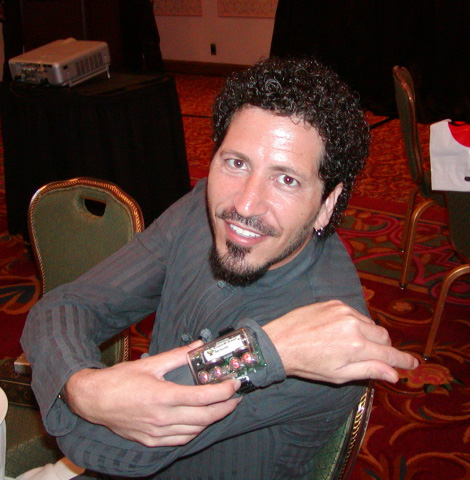
For you younger readers who don’t recognize what’s in the large plastic box on his wrist, those are mini Burroughs "Nixie" tubes, which were used in the first electronic, non‑mechanical calculators. Closely-spaced filaments forming the nine digits zero through nine can be individually lit up by applying power to the proper tube pins, causing the digit in question to appear in the tube. This watch used a small battery stepped up to the requisite high voltage to drive the Nixies. An utterly remarkable, and rare, product; there are a good number of Nixie clocks floating around but watches are virtually nonexistent.
And on his other arm, Steve was carrying Billy, his pet parrot—I guess this brings things back into our "colorful" theme quite well.
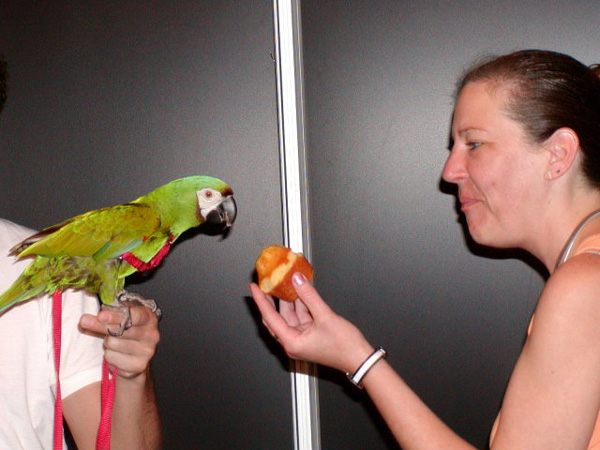
This marks a convenient stopping point for Part 2; we’ll carry on with additional systems in the next report.
